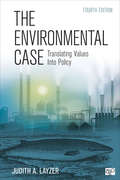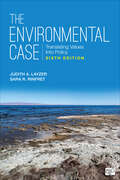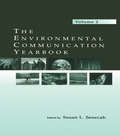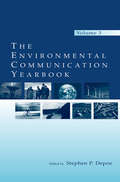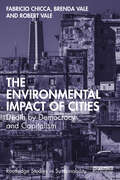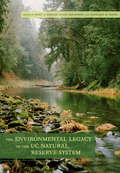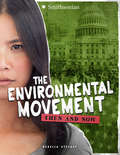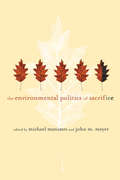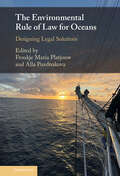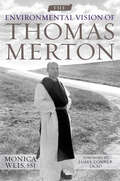- Table View
- List View
The Environmental Case: Translating Values Into Policy
by Judith A. LayzerAnswers to environmental issues are not black and white. Debates around policy are often among those with fundamentally different values, and the way that problems and solutions are defined plays a central role in shaping how those values are translated into policy. The Environmental Case captures the real-world complexity of creating environmental policy, and this much-anticipated Fourth Edition contains fifteen carefully constructed cases. Through her analysis, Editor Judith Layzer systematically explores the background, players, contributing factors, and outcomes of each case, and gives readers insight into some of the most interesting and controversial issues in U.S. environmental policymaking.
The Environmental Case: Translating Values Into Policy
by Judith A. Layzer Sara R. RinfretAnswers to environmental issues are not black and white. Debates around policy are often among those with fundamentally different values, and the way that problems and solutions are defined plays a central role in shaping how those values are translated into policy. The Environmental Case captures the real-world complexity of creating environmental policy, and this much-anticipated Fifth Edition contains fifteen carefully constructed cases. Through her analysis, Sara Rinfret explores the background, players, contributing factors, and outcomes of each case, and gives readers insight into some of the most interesting and controversial issues in U.S. environmental policymaking.
The Environmental Case: Translating Values Into Policy
by Judith A. Layzer Sara R. RinfretAnswers to environmental issues are not black and white. Debates around policy are often among those with fundamentally different values, and the way that problems and solutions are defined plays a central role in shaping how those values are translated into policy. The Environmental Case captures the real-world complexity of creating environmental policy, and this much-anticipated Fifth Edition contains fifteen carefully constructed cases. Through her analysis, Sara Rinfret explores the background, players, contributing factors, and outcomes of each case, and gives readers insight into some of the most interesting and controversial issues in U.S. environmental policymaking.
The Environmental Case: Translating Values Into Policy
by Judith A. Layzer Sara R. RinfretAnswers to environmental issues are not black and white. Debates around policy are often among those with fundamentally different values, and the way that problems and solutions are defined plays a central role in shaping how those values are translated into policy. The Environmental Case captures the real-world complexity of creating environmental policy, and this much-anticipated Sixth Edition contains 14 carefully constructed cases, including a new study of the Salton Sea crisis. Through her analysis, Sara Rinfret continues the work of Judith Layzer and explores the background, players, contributing factors, and outcomes of each case, and gives readers insight into some of the most interesting and controversial issues in U.S. environmental policymaking.
The Environmental Case: Translating Values Into Policy
by Judith A. Layzer Sara R. RinfretAnswers to environmental issues are not black and white. Debates around policy are often among those with fundamentally different values, and the way that problems and solutions are defined plays a central role in shaping how those values are translated into policy. The Environmental Case captures the real-world complexity of creating environmental policy, and this much-anticipated Sixth Edition contains 14 carefully constructed cases, including a new study of the Salton Sea crisis. Through her analysis, Sara Rinfret continues the work of Judith Layzer and explores the background, players, contributing factors, and outcomes of each case, and gives readers insight into some of the most interesting and controversial issues in U.S. environmental policymaking.
The Environmental Case: Translating Values into Policy, Fourth Edition
by Judith A. LayzerThrough its 15 carefully constructed cases, the book gives readers a first-hand look at some of the most interesting landmark and illuminating new controversies in U. S. environmental policy making. In her new section "New Issues, New Politics," Layzer adds two brand new cases: The Deepwater Horizon Disaster: The High Cost of Offshore Oil; and Fracking Wars: Local and State Responses to Unconventional Shale Gas Development. Lazyer provides maps, tables, figures, questions to consider, recommended readings, and useful websites to help students think critically about environmental policy and to facilitate further research.
The Environmental Communication Yearbook: Volume 1
by Susan L. SenecahEditorial ScopeThe Environmental Communication Yearbook is a multidisciplinary forum through which a broad audience of academics, professionals, and practitioners can share and build theoretical, critical, and applied scholarship addressing environmental communication in a variety of contexts. This peer-reviewed annual publication invites submissions that showcase and/or advance our understanding of the production, reception, contexts, or processes of human communication regarding environmental issues. Theoretical expositions, literature reviews, case studies, cultural and mass media studies, best practices, and essays on emerging issues are welcome, as are both qualitative and quantitative methodologies. Areas of topical coverage will include:*participatory processes: public participation, collaborative decision making, dispute resolution, consensus building processes, regulatory negotiations, community dialogue, building civic capacity;*journalism and mass communications: newspaper, magazine, book and other forms of printed mass media; advertising and public relations; media studies; and radio, television, and Internet broadcasting; and*communication studies: rhetorical/historical case studies, organizational analyses, public relations/issues management, interpersonal/relational dimensions, risk communication, and psychological/cognitive research, all of which examine the origins, content, structure, and outcomes of discourse about environmental issues. Submissions are accepted on an ongoing basis for inclusion in volumes published annually. AudienceResearchers, scholars, students and practitioners in environmental communication, journalism, rhetoric, public relations, mass communication, risk analysis, political science, environmental education, environmental studies, public administrations; policymakers; others interested in environmental issues and the communication channels used for discourse and information dissemination on the topic.For more information and guidelines for submissions, visit www.erlbaum.com/ecy.htm.
The Environmental Communication Yearbook: Volume 2
by Susan L. SenecahEditorial ScopeThe Environmental Communication Yearbook is a multidisciplinary forum through which a broad audience of academics, professionals, and practitioners can share and build theoretical, critical, and applied scholarship addressing environmental communication in a variety of contexts. This peer-reviewed annual publication invites submissions that showcase and/or advance our understanding of the production, reception, contexts, or processes of human communication regarding environmental issues. Theoretical expositions, literature reviews, case studies, cultural and mass media studies, best practices, and essays on emerging issues are welcome, as are both qualitative and quantitative methodologies. Areas of topical coverage will include:*participatory processes: public participation, collaborative decision making, dispute resolution, consensus building processes, regulatory negotiations, community dialogue, building civic capacity;*journalism and mass communications: newspaper, magazine, book and other forms of printed mass media; advertising and public relations; media studies; and radio, television, and Internet broadcasting; and*communication studies: rhetorical/historical case studies, organizational analyses, public relations/issues management, interpersonal/relational dimensions, risk communication, and psychological/cognitive research, all of which examine the origins, content, structure, and outcomes of discourse about environmental issues. Submissions are accepted on an ongoing basis for inclusion in volumes published annually. AudienceResearchers, scholars, students and practitioners in environmental communication, journalism, rhetoric, public relations, mass communication, risk analysis, political science, environmental education, environmental studies, public administrations; policymakers; others interested in environmental issues and the communication channels used for discourse and information dissemination on the topic.For more information and guidelines for submissions, visit www.erlbaum.com/ecy.htm.
The Environmental Communication Yearbook: Volume 3
by Stephen P. DepoeFirst Published in 2006. For scholars and students in environmental communications, journalism, rhetoric, PR, mass communication and other related areas.
The Environmental Humanities: A Critical Introduction (The\mit Press Ser. #1)
by David E. Nye Robert S. EmmettA concise overview of this multidisciplinary field, presenting key concepts, central issues, and current research, along with concrete examples and case studies.The emergence of the environmental humanities as an academic discipline early in the twenty-first century reflects the growing conviction that environmental problems cannot be solved by science and technology alone. This book offers a concise overview of this new multidisciplinary field, presenting concepts, issues, current research, concrete examples, and case studies. Robert Emmett and David Nye show how humanists, by offering constructive knowledge as well as negative critique, can improve our understanding of such environmental problems as global warming, species extinction, and over-consumption of the earth's resources. They trace the genealogy of environmental humanities from European, Australian, and American initiatives, also showing its cross-pollination by postcolonial and feminist theories. Emmett and Nye consider a concept of place not synonymous with localism, the risks of ecotourism, and the cultivation of wild areas. They discuss the decoupling of energy use and progress, and point to OECD countries for examples of sustainable development. They explain the potential for science to do both good and harm, examine dark visions of planetary collapse, and describe more positive possibilities—alternative practices, including localization and degrowth. Finally, they examine the theoretical impact of new materialism, feminism, postcolonial criticism, animal studies, and queer ecology on the environmental humanities.
The Environmental Imaginary In Brazilian Poetry And Art
by Malcolm K. McneeThis study contributes to ongoing discussions on the connections between the environmental imaginary and issues of identity, place and nation. Utilizing a delimited ecocritical approach, McNee puts Brazilian culture, through the work of contemporary poets and visual artists, into a broader, transnational dialogue.
The Environmental Imagination: Thoreau, Nature Writing and the Formation of American Culture
by Lawrence BuellThe author provides a major new understanding of Thoreau's achievement and, at the same time, a profound rethinking of our literary and cultural reflections on nature.
The Environmental Imagination: Thoreau, Nature Writing, and the Formation of American Culture (Wiley-blackwell Manifestos Ser.)
by Lawrence BuellWith the environmental crisis comes a crisis of the imagination, a need to find new ways to understand nature and humanity's relation to it. This is the challenge Lawrence Buell takes up in The Environmental Imagination, the most ambitious study to date of how literature represents the natural environment. With Thoreau's Walden as a touchstone, Buell gives us a far-reaching account of environmental perception, the place of nature in the history of western thought, and the consequences for literary scholarship of attempting to imagine a more "ecocentric" way of being. In doing so, he provides a major new understanding of Thoreau's achievement and, at the same time, a profound rethinking of our literary and cultural reflections on nature. The green tradition in American writing commands Buell's special attention, particularly environmental nonfiction from colonial times to the present. In works by writers from Crevecoeur to Wendell Berry, John Muir to Aldo Leopold, Rachel Carson to Leslie Silko, Mary Austin to Edward Abbey, he examines enduring environmental themes such as the dream of relinquishment, the personification of the nonhuman, an attentiveness to environmental cycles, a devotion to place, and a prophetic awareness of possible ecocatastrophe. At the center of this study we find an image of Walden as a quest for greater environmental awareness, an impetus and guide for Buell as he develops a new vision of environmental writing and seeks a new way of conceiving the relation between human imagination and environmental actuality in the age of industrialization. Intricate and challenging in its arguments, yet engagingly and elegantly written, The Environmental Imagination is a major work of scholarship, one that establishes a new basis for reading American nature writing.
The Environmental Impact of Cities: Death by Democracy and Capitalism (Routledge Studies in Sustainability)
by Robert Vale Brenda Vale Fabricio ChiccaThe Environmental Impact of Cities assesses the environmental impact that comes from cities and their inhabitants, demonstrating that our current political and economic systems are not environmentally sustainable because they are designed for endless growth in a system which is finite. It is already well documented that political, economic and social forces are capable of shaping cities and their expansion, retraction, gentrification, re-population, industrialisation or de-industrialisation. However, the links between these political and economic forces and the environmental impact they have on urban areas have yet to be numerically presented. As a result, it is not clear how our cities are affecting the environment, meaning it is currently impossible to relate their economic, political and social systems to their environmental performance. This book examines a broad selection of cities covering a wide range of political systems, geography, cultural backgrounds and population size. The environmental impact of the selected cities is calculated using both ecological footprint and carbon emissions, two of the most extensively available indices for measuring environmental impact. The results are then considered in terms of political, economic and social factors to ascertain the degree to which these factors are helping or hindering the reduction of the environmental impact of humans. This book will be of great interest to students and scholars of sustainability, urban planning, urban design, environmental sciences, geography and sociology.
The Environmental Impact of Overpopulation: The Ethics of Procreation (Routledge Explorations in Environmental Studies)
by Trevor HedbergThis book examines the link between population growth and environmental impact and explores the implications of this connection for the ethics of procreation. In light of climate change, species extinctions, and other looming environmental crises, Trevor Hedberg argues that we have a collective moral duty to halt population growth to prevent environmental harms from escalating. This book assesses a variety of policies that could help us meet this moral duty, confronts the conflict between protecting the welfare of future people and upholding procreative freedom, evaluates the ethical dimensions of individual procreative decisions, and sketches the implications of population growth for issues like abortion and immigration. It is not a book of tidy solutions: Hedberg highlights some scenarios where nothing we can do will enable us to avoid treating some people unjustly. In such scenarios, the overall objective is to determine which of our available options will minimize the injustice that occurs. This book will be of great interest to those studying environmental ethics, environmental policy, climate change, sustainability, and population policy.
The Environmental Impact of Overpopulation: The Ethics of Procreation (Routledge Explorations in Environmental Studies)
by Trevor HedbergThis book examines the link between population growth and environmental impact and explores the implications of this connection for the ethics of procreation.In light of climate change, species extinctions, and other looming environmental crises, Trevor Hedberg argues that we have a collective moral duty to halt population growth to prevent environmental harms from escalating. This book assesses a variety of policies that could help us meet this moral duty, confronts the conflict between protecting the welfare of future people and upholding procreative freedom, evaluates the ethical dimensions of individual procreative decisions, and sketches the implications of population growth for issues like abortion and immigration. It is not a book of tidy solutions: Hedberg highlights some scenarios where nothing we can do will enable us to avoid treating some people unjustly. In such scenarios, the overall objective is to determine which of our available options will minimize the injustice that occurs.This book will be of great interest to those studying environmental ethics, environmental policy, climate change, sustainability, and population policy.Chapter 5 of this book is freely available as a downloadable Open Access PDF at http://www.taylorfrancis.com under a Creative Commons [Attribution-Non Commercial-No Derivatives (CC-BY-NC-ND)] 4.0 license.
The Environmental Legacy of the UC Natural Reserve System
by Kathleen M. Wong Peggy L. Fiedler Susan Gee RumseyThe UC Natural Reserve System, established in 1965 to support field research, teaching, and public service in natural environments, has become a prototype of conservation and land stewardship looked to by natural resource managers throughout the world. From its modest beginnings of seven sites, the UC NRS has grown to encompass more than 750,000 wildland acres. This book tells the story of how a few forward-thinking UC faculty, who'd had their research plots and teaching spots destroyed by development and habitat degradation, devised a way to save representative examples of many of California's major ecosystems. Working together with conservation-minded donors and landowners, with state and federal agencies, and with land trusts and private conservation organizations, they founded what would become the world's largest university-administered natural reserve system--a legacy of lasting significance and utility. This lavishly illustrated volume, which includes images by famed photographers Ansel Adams and Galen Rowell, describes the natural and human histories of the system's many reserves. Located throughout California, these wildland habitats range from coastal tide pools to inland deserts, from lush wetlands to ancient forests, and from vernal pools to oak savannas. By supporting teaching, research, and public service within such protected landscapes, the UC NRS contributes to the understanding and wise stewardship of the Earth.
The Environmental Movement: Then and Now (America: 50 Years of Change)
by Rebecca StefoffDiscusses the main concerns of the environmental movement in the 1960s, and how those have evolved since; what's changed for the better, what might be worse, and where do we go from here.
The Environmental Pendulum: A Quest for the Truth about Toxic Chemicals, Human Health, and Environmental Protection
by R. Allan FreezeThe pendulum of environmental policy swings from one extreme to the other, depending on which camp is in power and who has the ear of the media. Underkill is followed by overkill. Concern breeds action; disillusion breeds reaction. The Environmental Pendulum provides a thoughtful and evenhanded assessment of this conflict. Tens of thousands of sites across the country are contaminated with toxic chemicals. Environmentalists warn us that this legacy of carelessness is seriously affecting both human health and the ecological balance of nature. They point out that even improved industrial practices will not eliminate future chemical releases to the environment. Their demand for regulatory control has received wide public support and led to the passage of the Superfund legislation in 1980. Now, after twenty years, the value of the Superfund program is being challenged by corporate America, which argues that excessive cleanup costs have the potential to bankrupt the nation. R. Allan Freeze outlines the difficulties associated with the management of hazardous waste and offers a balanced account of the controversy over the role of environmental contamination in human health. Freeze clarifies what matters and what doesn't with respect to chemical contaminants in the environment, arguing that environmental policies should be based on an accurate appraisal of the risks associated with these toxins. He concludes the book with a brilliant summation of the good news and the bad news of environmental pollution, describing what can and can't be done to bring the situation under control.
The Environmental Policy Paradox
by Zachary A. Smith Peter JacquesNow in its eighth edition, The Environmental Policy Paradox continues the book's tradition of offering an accessible introduction to the social, economic, legal, and political matters pertaining to environmental policy while also developing the student’s own unique views. The text explains why some environmental ideas shape policy while others do not and illustrates that even when the best short- and long-term solutions to environmental problems are identified, the task of implementing these solutions is often left undone or is completed too late. New to the eighth edition: New topics including environmental social movements and the anti-environmental countermovements, environmental justice, corporate influence in regulatory affairs. Analyzes the growing policy divide between the two parties, and the efforts of both Republicans and Democratic presidents to undo the policies of their predecessor. Updated discussions of environmental justice issues. Includes a range of visual aids in figures and tables to demonstrate trends in the topics covered. A new co-author, Peter Jacques, recognized for his teaching and scholarship in global environmental politics and sustainability. A must-buy for courses in Environmental Policy, Environmental Studies, and Public Policy; and as a supplement for courses in American Government and Public Administration.
The Environmental Politics of Sacrifice (The\mit Press Ser.)
by John M. Meyer Edited by Michael ManiatesAn argument that the idea of sacrifice, with all its political baggage, opens new paths to environmental sustainability.The idea of sacrifice is the unspoken issue of environmental politics. Politicians, the media, and many environmentalists assume that well-off populations won't make sacrifices now for future environmental benefits and won't change their patterns and perceptions of consumption to make ecological room for the world's three billion or so poor eager to improve their standard of living. The Environmental Politics of Sacrifice challenges these assumptions, arguing that they limit our policy options, weaken our ability to imagine bold action for change, and blind us to the ways sacrifice already figures in everyday life. The concept of sacrifice has been curiously unexamined in both activist and academic conversations about environmental politics, and this book is the first to confront it directly. The chapters bring a variety of disciplinary perspectives to the topic. Contributors offer alternatives to the conventional wisdom on sacrifice; identify connections between sacrifice and human fulfillment in everyday life, finding such concrete examples as parents' sacrifices in raising children, religious practice, artists' pursuit of their art, and soldiers and policemen who risk their lives to do their jobs; and examine particular policies and practices that shape our understanding of environmental problems, including the carbon tax, incentives for cyclists, and the perils of green consumption. The Environmental Politics of Sacrifice puts “sacrifice” firmly into the conversation about effective environmental politics and policies, insisting that activists and scholars do more than change the subject when the idea is introduced.ContributorsPeter Cannavò, Shane Gunster, Cheryl Hall, Karen Litfin, Michael Maniates, John M. Meyer, Simon Nicholson, Anna Peterson, Thomas Princen, Sudhir Chella Rajan, Paul Wapner, Justin Williams
The Environmental Rule of Law for Oceans: Designing Legal Solutions
by Froukje Maria Platjouw Alla PozdnakovaOur oceans need a strong and effective environmental rule of law to protect them against increased pressures and demands, including climate change, pollution, fisheries, shipping and more. The environmental rule of law for oceans requires the existence of a set of rules and policies at multiple governance levels that appropriately regulate human activities at sea and ensure that pressures on the marine ecosystem are tackled effectively. Adhering to the rule of law through clear, predictable, coherent, and legitimate rules, and their implementation and enforcement, is timely and urgent. In this book, we are searching for ways to improve, strengthen and further develop the environmental rule of law for oceans. The book provides future-oriented perspectives on how law should evolve to better preserve the oceans. All chapters incorporate novel insights and ideas for legal solutions that might inspire scholars, actors, authorities, citizens and communities around the globe. This title is Open Access.
The Environmental Sustainable Development Goals in Bangladesh (Routledge Focus on Environment and Sustainability)
by Carolyn Roberts Rumana Sultana Samiya Selim Shantanu SahaThis book examines the key Sustainable Development Goals (SGDs) relating to environmental sustainability and provides a cutting-edge assessment of current progress with the view of achieving these goals by 2030. Within South Asia, the book pays particular attention to Bangladesh, as a country representative of emerging economies which are struggling to meet their goals. Drawing on the three pillars of sustainability, the volume addresses the following goals: Clean Water and Sanitation, Affordable and Clean Energy, Responsible Consumption and Production, Climate Action, Life Below Water and Life on Land (Goals 6, 7, 12, 13, 14 and 15). The book examines where progress has been made and why some key targets have not been achieved or will be difficult to achieve. The chapters focus on environmental sustainability in different sectors such as agriculture, renewable energy, fisheries and aquaculture and natural resource management. The aim of this volume is to highlight key lessons and recommendations on how research in the various sectors can feed into the pathway of meeting the SDGs highlighted in this book. The analysis derived from Bangladesh can be used as a reference point for other developing nations in Asia, and globally, with a view to guiding policy for the achievement of the SGDs. This book will be of great interest to students and scholars of sustainable development and climate change, as well as practitioners and policymakers involved in sustainable development and disaster management.
The Environmental Vision of Thomas Merton (Culture Of The Land Ser.)
by Monica Weis“Delightful . . . a superb guide to the ecological themes of Merton’s life and writings.” ?The Christian CenturyNature was always vital in Thomas Merton’s life, from the long hours he spent as a child watching his father paint landscapes in the fresh air, to his final years of solitude in the hermitage at Our Lady of Gethsemani, where he contemplated and wrote about the beauty of his surroundings. Throughout his life, Merton’s study of the natural world shaped his spirituality in profound ways, and he was one of the first writers to raise concern about ecological issues that have become critical in recent years.In The Environmental Vision of Thomas Merton, Monica Weis suggests that Merton’s interest in nature, which developed significantly during his years at the Abbey of Gethsemani, laid the foundation for his growing environmental consciousness. Tracing Merton’s awareness of the natural world from his childhood to the final years of his life, Weis explores his deepening sense of place and desire for solitude, his love and responsibility for all living things, and his evolving ecological awareness.“Explains how Merton evolved from a nature enthusiast . . . to one of the world’s most respected ecological stewards.” ?Louisville Courier Journal
The Equitable Forest: Diversity, Community, and Resource Management
by Carol J. Pierce ColferWhile there continues to be refinement in defining and assessing sustainable management, there remains the urgent need for policies that create the conditions that support sustainability and can halt or slow destructive practices already underway. Carol Colfer and her contributors maintain that standardized solutions to forest problems from afar have failed to address both human and environmental needs. Such approaches, they argue, often neglect the knowledge that local stakeholders have accumulated over generations as forest managers and do not address issues involving the diversity and well-being of groups within communities. The contributors note that these problems persist despite clear evidence that equity and social relationships, including gender roles, are important factors in the ways that communities adapt to change and manage forest resources overall. The Equitable Forest offers an alternative to traditional, externally organized strategies for forest management. Termed adaptive collaborative management (ACM), the approach tries to better acknowledge the diversity, complexity, and unpredictability of human and natural systems. ACM works to strengthen local institutions and use the knowledge and capacity of groups in local communities to enhance the health and well-being of both forests and the people who live in and around them. The Equitable Forest provides a detailed explanation of the descriptive, analytical, and methodological tools of ACM, along with accounts of early stages of its implementation in tropical regions of Asia, Africa, and Latin America. Although the contributors make it clear that it is too soon to evaluate the efficacy of ACM, their work is supported by evidence that rural communities do make important contributions when involved in formal forest management; that management strategies are most effective when flexible and tailored to local contexts; and that efforts by outside governmental and nongovernmental organizations to support local management are feasible from the policymaking perspective, and desirable for their impact on human, economic, and environmental well-being.
